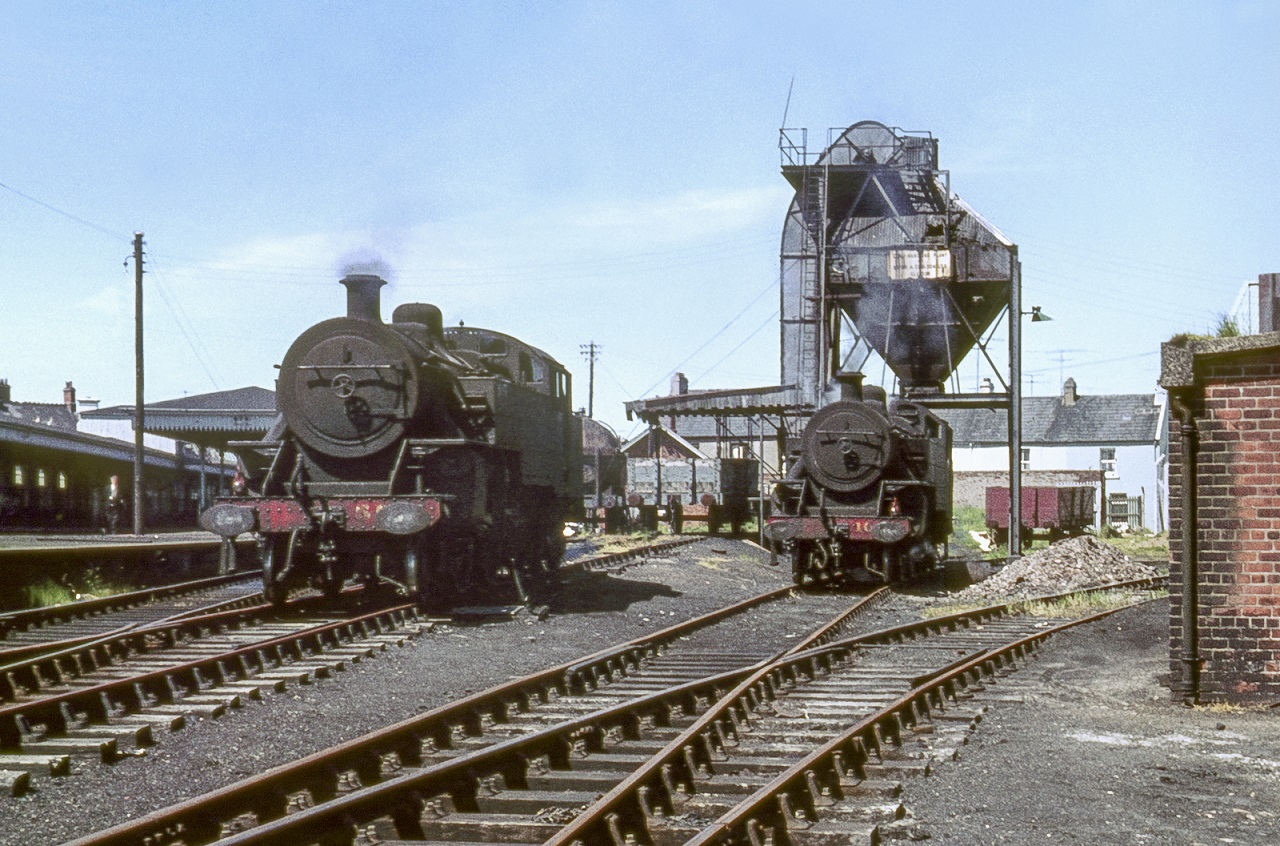
NIR Steam 56-15 Coleraine, 8th June 1968 (C) IRRS
The next major change for the railways came under the Transport Act of 1967, when Northern Ireland Railways (NIR) took over their responsibility, as UTA was split into road and rail operations (Ulsterbus became responsible for the bus network)
There had been substantial reduction of the route network in the 1950s and 1960s, from around 900 miles to 210 miles by the time NI Railways took over.
In 1969, the first ticket issuing conductors were appointed to work on the trains.
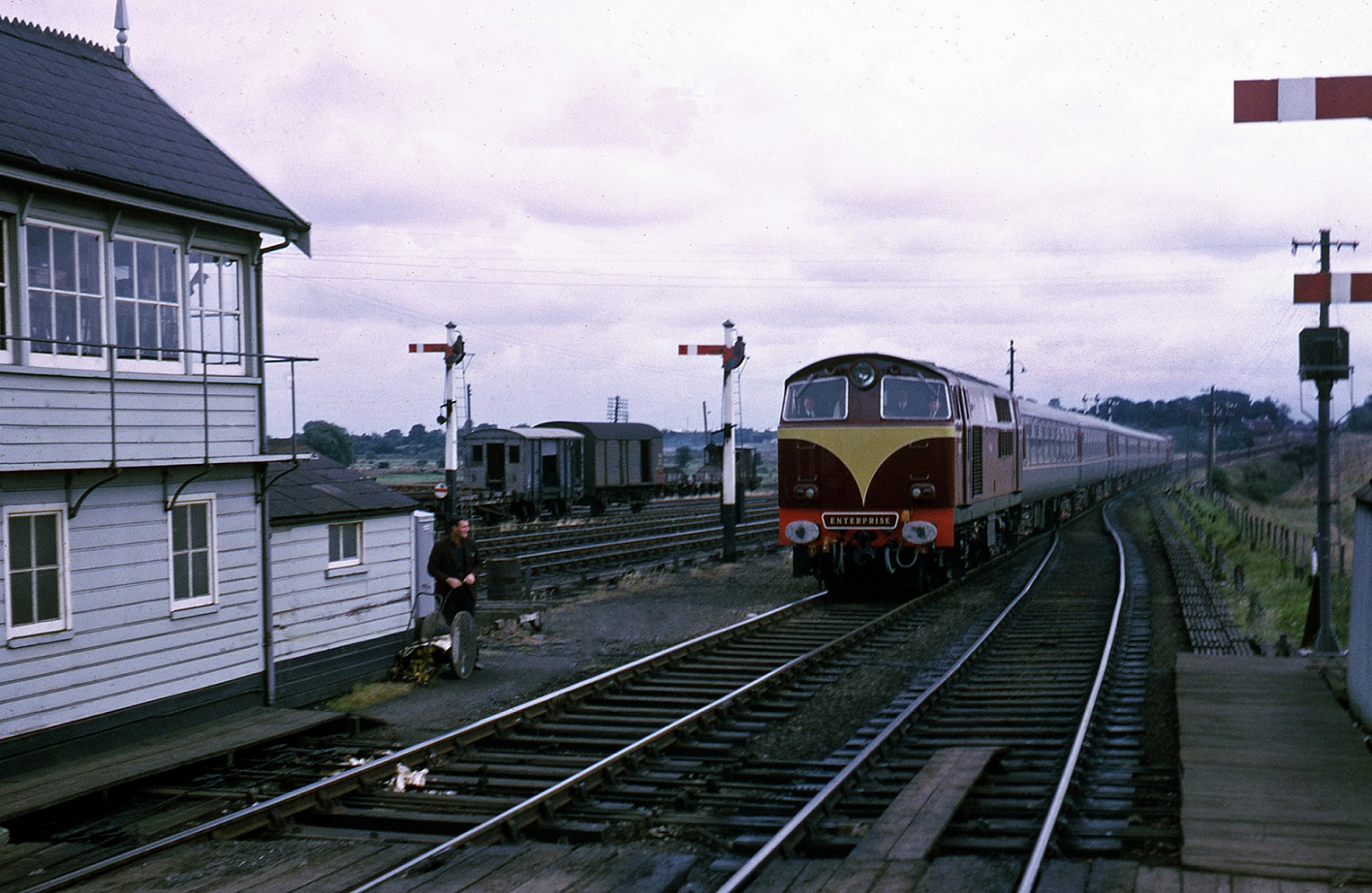
Enterprise in 1970 – Photo by WN Johnston courtesy of CP Friel
A year later, new Enterprise locomotives came into operation in named Eagle, Falcon and Merlin after steam engines which had previously operated on the Belfast to Dublin route. In mid-1973, blue and maroon Enterprise livery made its first appearance.
New stations opened at Portadown (formerly Craigavon West) with another halt between Portadown and Lurgan at the former Goodyear Tyre Factory in Craigavon.
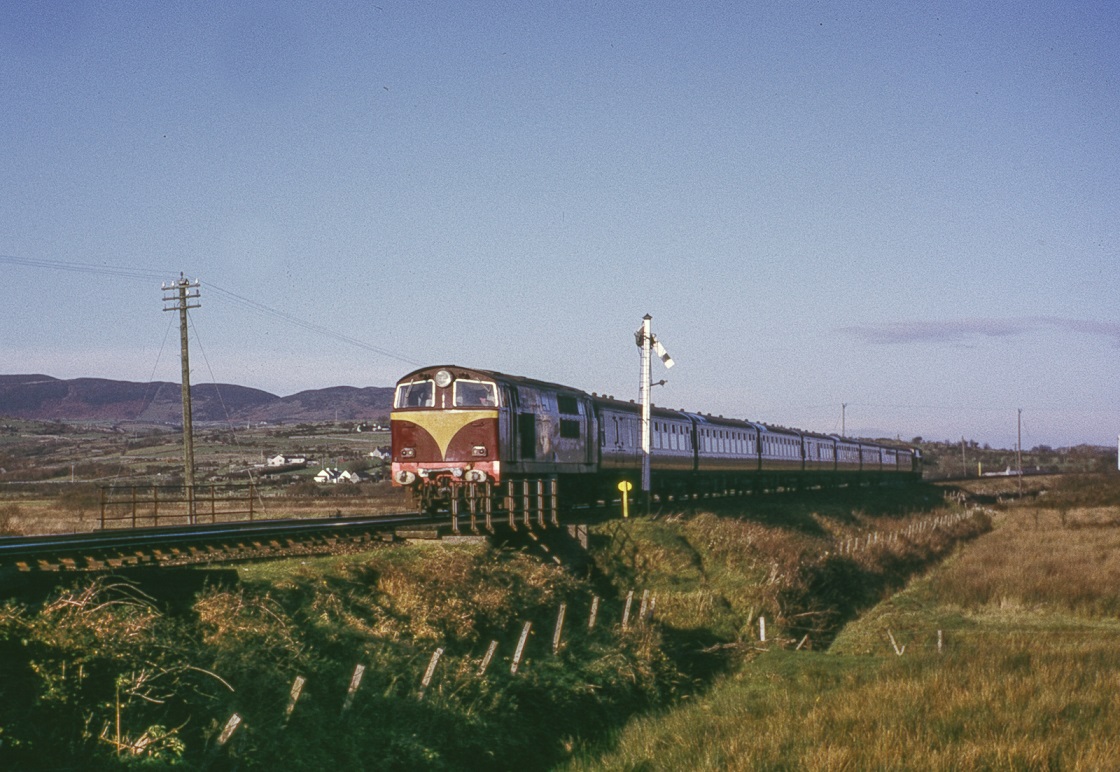
NIR Hunslet 102 Meigh 14th November 1970 (C) IRRS
Plans were also announced to re-open the Lisburn to Antrim line, to form part of a high speed route from Belfast to Derry~Londonderry.
In 1972, the largest project yet for NI Railways was announced, with plans to replace Belfast and County Down Railway’s Queens Quay station and the Great Northern Railway’s Great Victoria Street station with the Central Station project. New diesel/electric trains were also sanctioned.
Larne station opened in June 1974 and the first of the 80 Class sets arrived by the end of that year.
“CityTrack” trains for Belfast were launched in 1976 and the long-awaited Belfast Central to Bangor line opened. The new Belfast Central station, which was at the time seen as more modern and with better facilities than Great Victoria Street or Queens Quay stations, was also to become the departure point for Dublin, Portadown and Lisburn services. Great Victoria Street closed in April of that year.
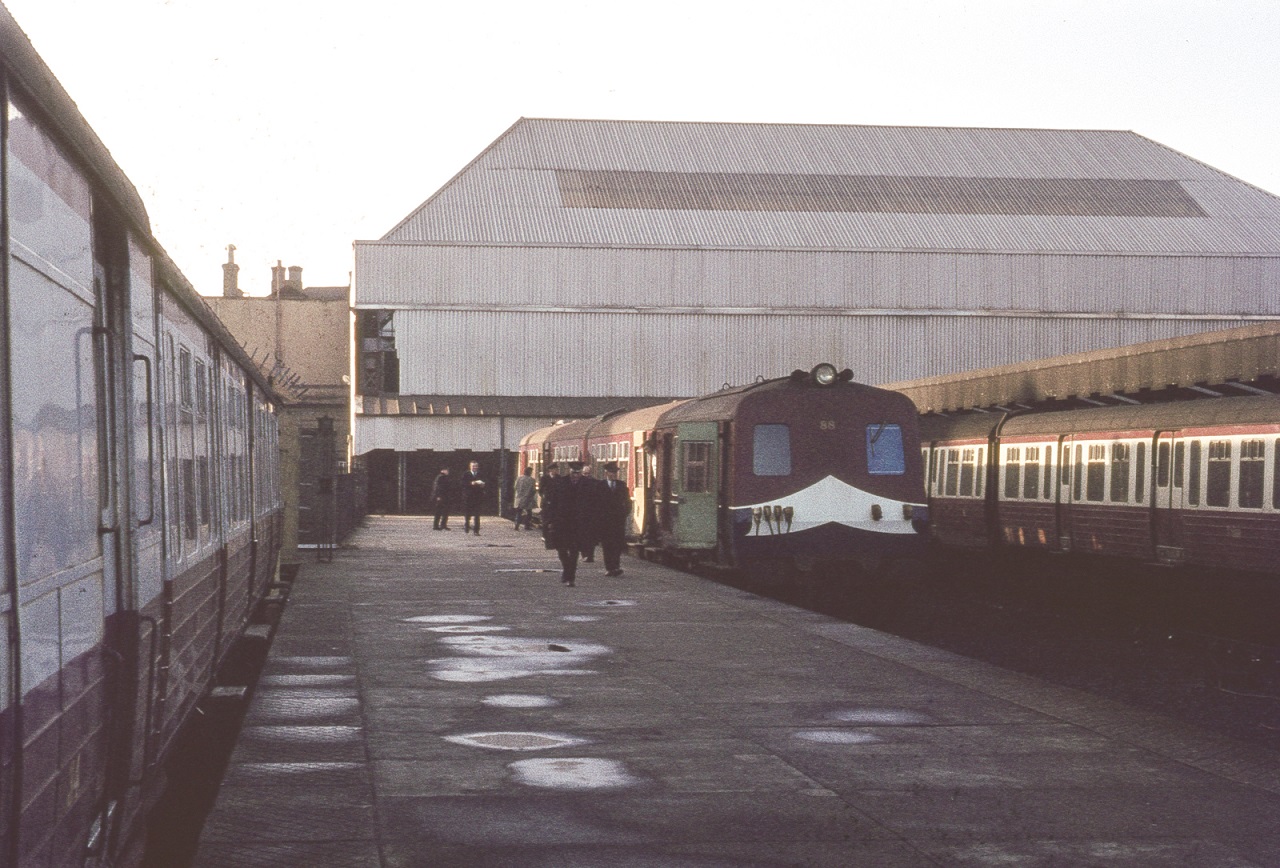
Queens Quay Station with NIR Railcar 88. 14th January 1976 (C) IRRS
In 1977 NIR took delivery of further 80 Class sets, nine 3 car and three 2 car. There were changes on the Larne Line, with the closure of halts at Eden, Killroot, Barn and Bleach Green, while a new halt was constructed on the Bangor Line, namely Bridge End.
There were improvements on the Derry~Londonderry line, which incorporated Lisburn after the closure of the signal cabin at Knockmore. These services transferred from Great Victoria Street to the new Central Station in 1978. That year also saw the reopening of Cultra station on the Bangor line for passengers travelling to the Ulster Folk and Transport Museum as well as the introduction of new blue and grey livery on the Enterprise.
A new station opened in Ballymena in 1979, at a cost of £250,000.
The 1970s was also a challenging decade - a number of stations were damaged in bombings in the 1970s, including Great Victoria Street on 22nd March 1972 when a number of railcars were also damaged; and on 21st July 1972 during Bloody Friday bombings - York Road was also targeted in the latter. Lurgan station was damaged in the same year. 1974 saw the newly completed Lurgan station damaged in a bombing, just a week before it was due to re-open in August; and Waterside station was similarly damaged in September. The Enterprise was derailed near Scarva in 1976, while an evening train from Bangor to Portadown was bombed outside Lisburn, killing one passenger and injuring 12 others.
The 1980s began with the opening of the Waterside Station in Derry~Londonderry and Lurgan station re-opened in October 1981.
Also in 1981, the Enterprise service was re-launched with two new trains, ‘Great Northern’ and ‘Northern Counties’. These were joined in 1984 by ‘Belfast and County Down’, replacing the 101s on the route. The 1980s also heralded the appearance of a four wheel railbus, RB3 on the Portrush branch, although this only operated for a short time.
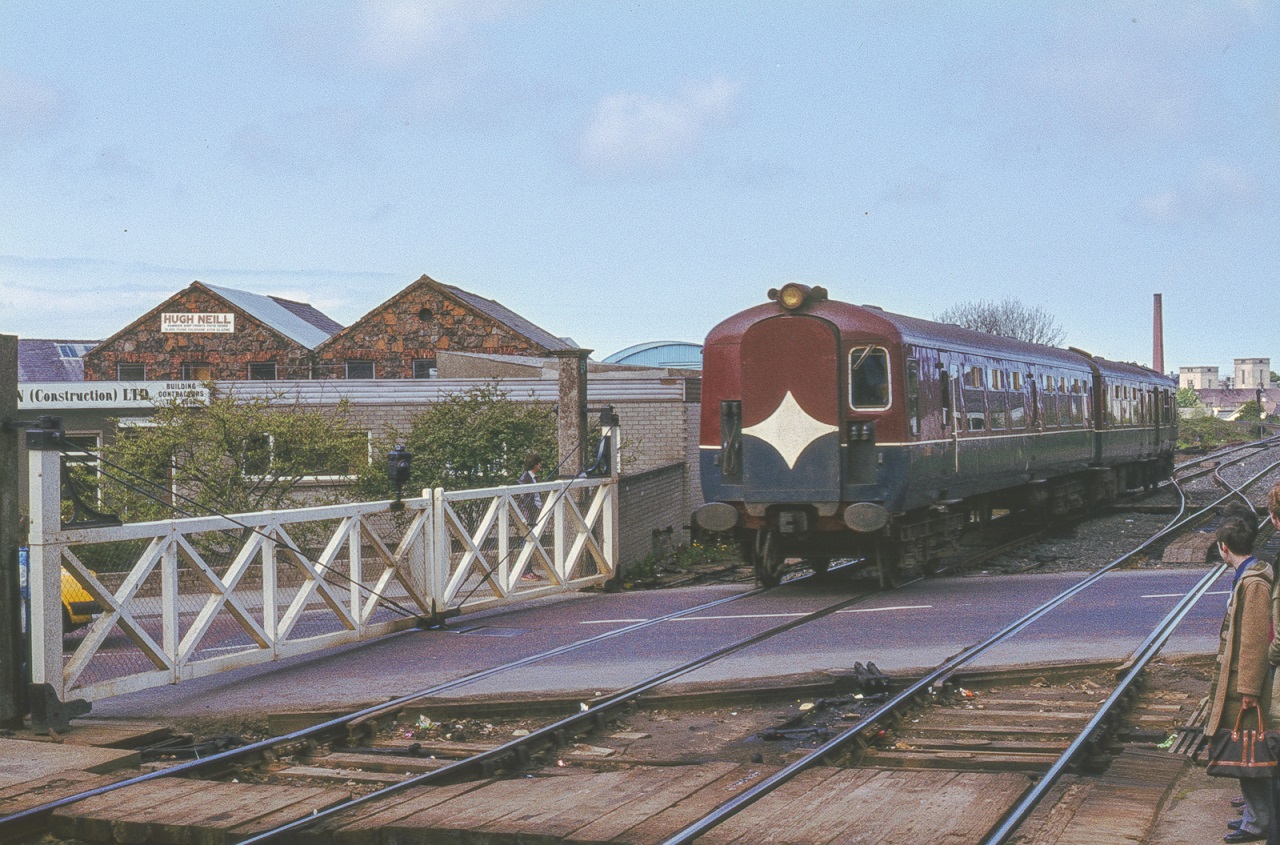
NIR Railcar Coleraine 21st May 1983 (C) IRRS
By 1983, it was planned to retire the 1960s 70 Class trains, but with limited funding available, a decision was made to refurbish their engines for use in their replacements, along with refurbished undercarriages for the railcars, although they did contain new bodies and interior fittings.
The 450 “Castle” Class trains began operating in 1985 as part of a rolling stock upgrade. In all, there were nine 3 car sets.
A signalling upgrade was also underway across the network. In the mid-1980s electric signalling came into effect at Lisburn and on the Larne and Bangor lines.
City Hospital halt opened in 1986 and plans were put forward to re-open the line to Great Victoria Street which had by now been closed for a decade, however, at this time, they were rejected.
1987 saw a radical overhaul of NIRs services, with the network divided into “Suburban” for NI routes, “Inter City” for cross-border and “Freight”. This also saw new liveries introduced for all but the freight services.
In 1989 Iarnrod Eireann and NI Railways formulated joint plans for an improved cross-border service. Proposals for a light railway service in greater Belfast were also launched, including lines to Greencastle and Dundonald.
The 1990s started with the phasing out of all ungated level crossings on the network and the opening of a new station at Greenisland.
The double track between Antrim and Ballymena was reduced to single line, with a passing loop at Magherabeg. Whitehead station opened in December 1993 after a refurbishment programme.
Work on the Belfast cross-harbour rail link – the Dargan Bridge -began in 1991, a massive project which took around three years to complete and included a new station at Yorkgate.
Other changes in the mid-1990s included the transfer of engineering from Central Services Depot at Queen’s Quay to York Road and resignalling of the Coleraine to Ballymena line.
The line extension to Great Victoria Street re-opened in September 1995, as part of a combined upgraded facility with the Europa Buscentre, representing investment of £6 million.
Lisburn station underwent a refurbishment project in 1995 while work was also carried out at Carrickfergus station.
The upgrade of the Belfast to Dublin cross-border line was also moving ahead, with new sections of track to cater for heavier trains, higher speeds and new rolling stock. This joint project, funded by London and Dublin, also saw the end of the manual signal at Poyntzpass.
The new trains, with General Motors engines and De Dietrich Ferroviaire carriages, came into operation in 1997, using green/grey Enterprise livery.
Towards the end of the 1990s work started to re-open the 15 mile-long Bleach Green to Antrim line, which had been closed since 1978. The result was a single line with a station and passing loop at Templepatrick and an additional station at Mossley West.
In 2001, Stormont sanctioned investment for new trains. This resulted in the purchase of twenty three Class 3000 3 car sets from Spanish firm Construcciones y Auxiliar De Ferrocarriles (CAF) to replace the 80 Class trains. They came into operation in 2005.
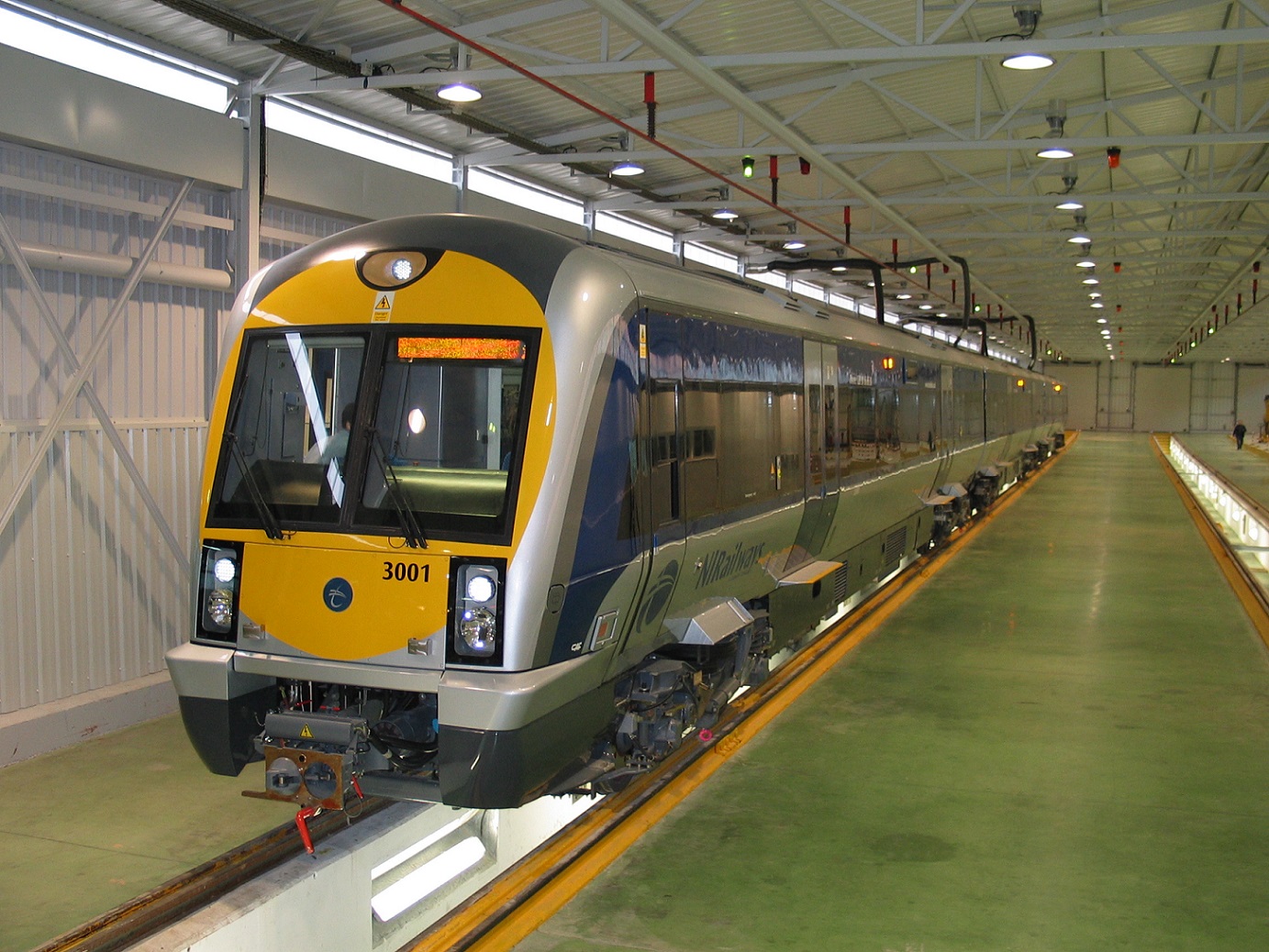
New CAF 3K train 2005
Bangor’s new rail and bus station opened in January 2001, the new station at Coleraine opened in May, with a revamped Carrickfergus station following suit in August. Mossley West station on the Bleach Green/Antrim line was opened to the public in October.
The refurbishment of Belfast Central station was finished in 2003, providing a new concourse, a bar/restaurant, improved toilet facilities and platform access ramps at a cost of £3.8 million.
2009 saw the introduction of new livery for the Enterprise. The trains were resprayed in silver with green livery.
Twenty new Class 4000 CAF trains entered service between September 2011 and the summer of 2012.
In 2014, a mid-life refurbishment programme was announced for the Enterprise trains, including new mechanical running gear, in-coach electronics and modernised interiors. The refurbishment was officially completed on 10 April 2016, to coincide with the introduction of an enhanced Belfast to Dublin timetable.
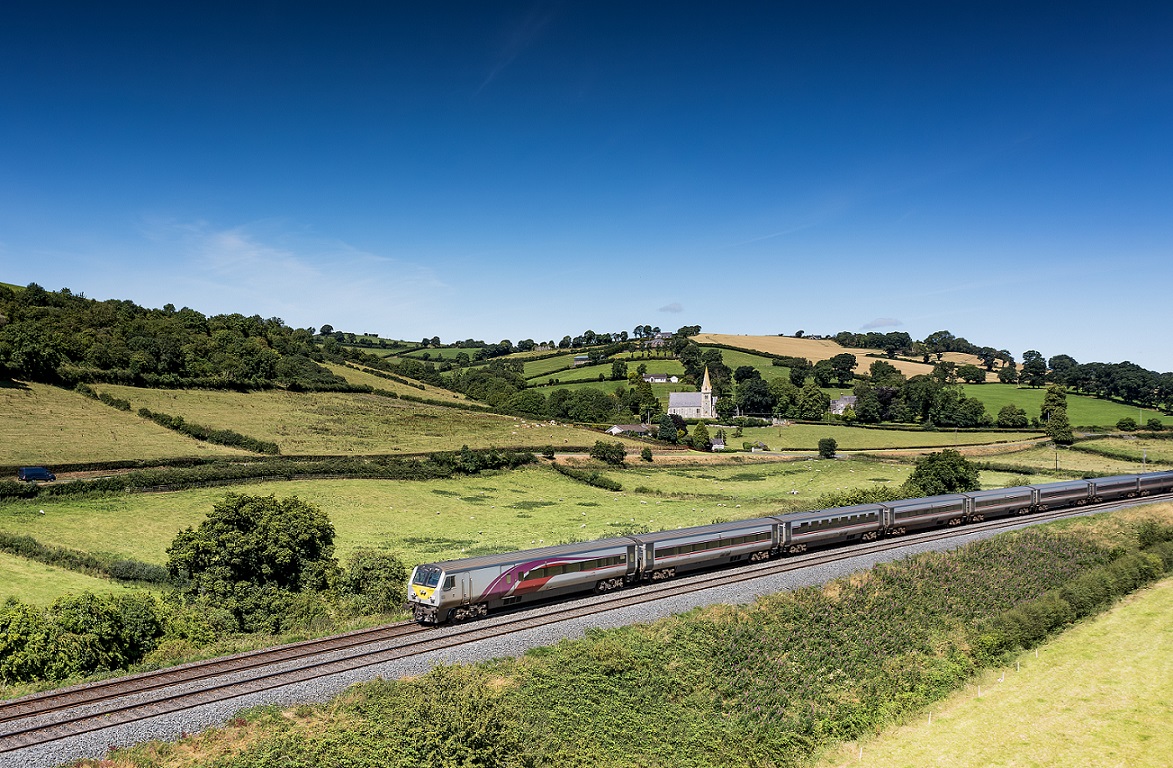
Enterprise De Dietrich train
2017 saw the arrival of a new Windhoff built Multi-Purpose Vehicle (MPV) to improve rail adhesion during leaf fall season. It can also undertake other work including weed spraying.
Hourly services began on the Belfast to Derry~Londonderry line in July 2017, following investment of £46.4 million to complete a passing loop and installation of new signalling and telecoms between Coleraine and Derry~Londonderry.
Belfast Central Station was renamed Lanyon Place in Sept 2018 after a series of improvement works including a more modern and welcoming exterior and changes to the ticketing area.
The new Portrush train station opened in June 2019, ahead of the 148th Open Golf Championship, with modern waiting facilities, improved passenger information and signage to local amenities and attractions, as well as enhanced cycle storage. The increased capacity allows for further passenger and visitor growth, as well as delivering wider economic benefits to the area. A time capsule was also installed on-site.
The North-West Transport Hub in Derry~Londonderry opened for passengers in October 2019. It is located at the former Waterside Train Station, a Grade B-listed 19th century building which served as one of the city’s main stations for a century before closing in 1980. The North-West Transport Hub provides a 100-space park and ride site (including accessibility parking and e-charge points), a bus turning circle and access to the local greenway.
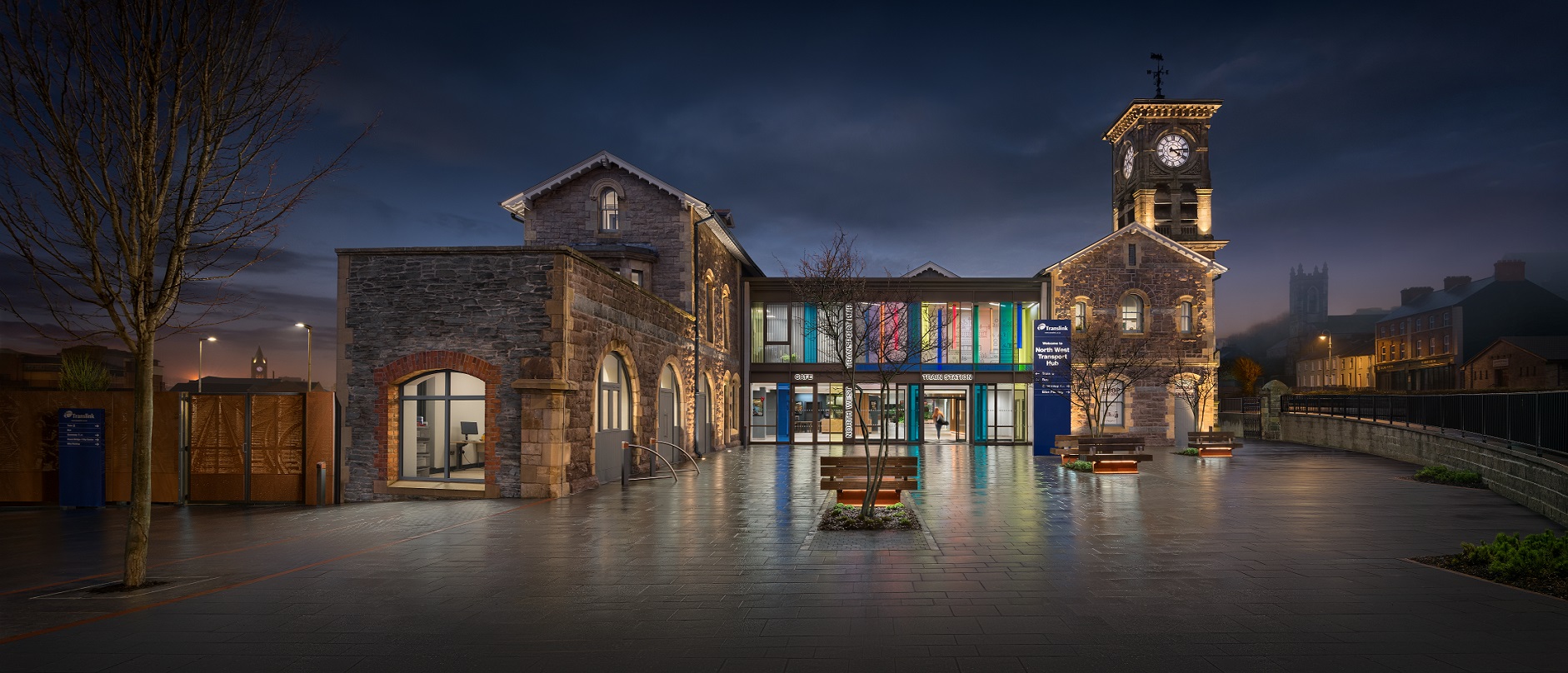
North-West Transport Hub
Seven six-carriage walkthrough trains came into operation in 2022. Twenty one new carriages were combined with 7 refurbished Class 4000 trains, bringing an additional 1600 seats to the train network.
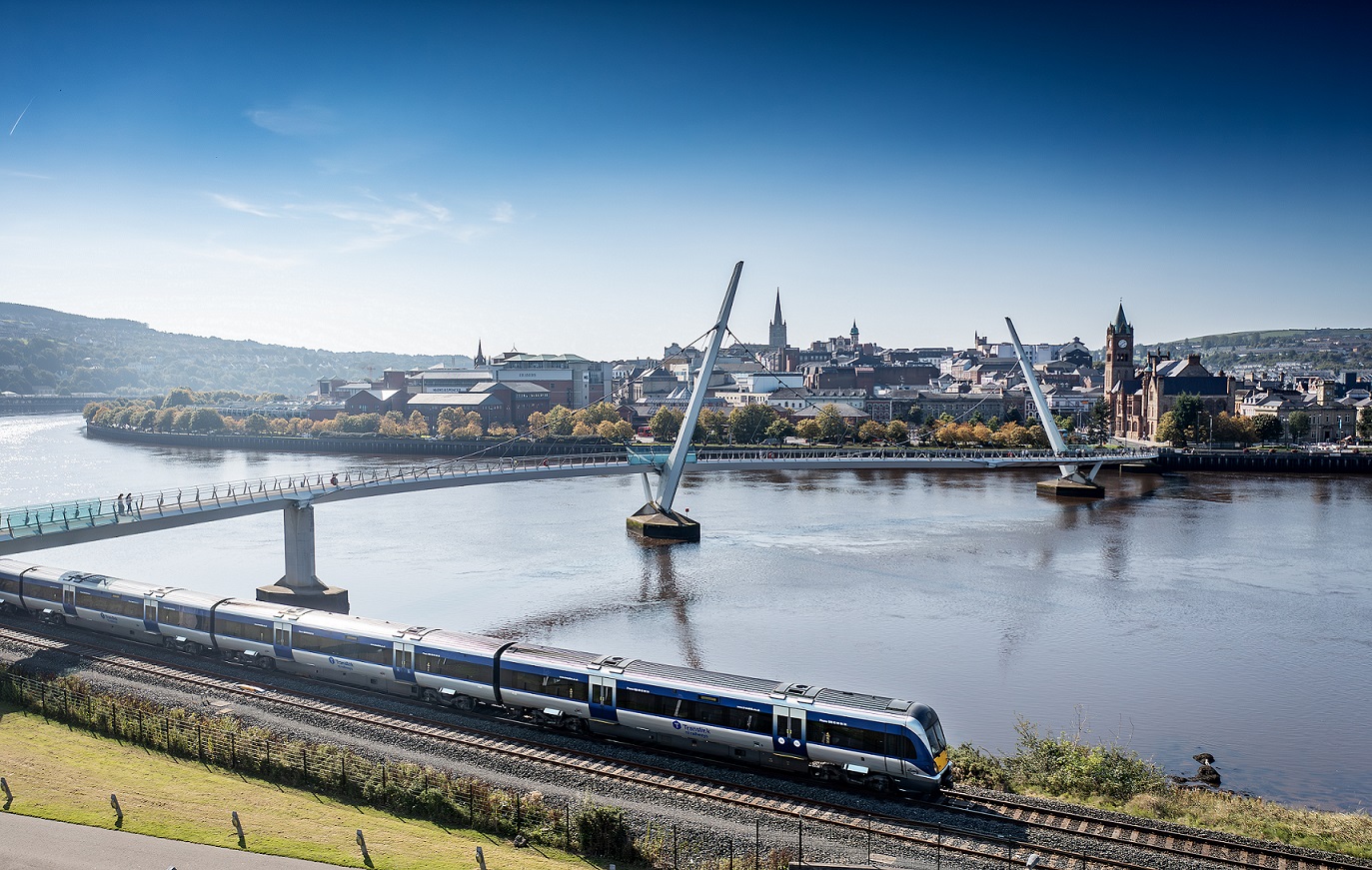
Class 4K 6 carriage walkthrough train
The new York Street station, a modern, accessible and welcoming passenger facility, opened in Spring 2024, replacing railway facilities at Yorkgate. It is seen as a catalyst for development and regeneration in the area, as well as being a major gateway to both the communities of north Belfast and the city centre. It will also be a point of access to the Ulster University campus and Sailortown, ensuring that local communities in this area are better connected by public transport.
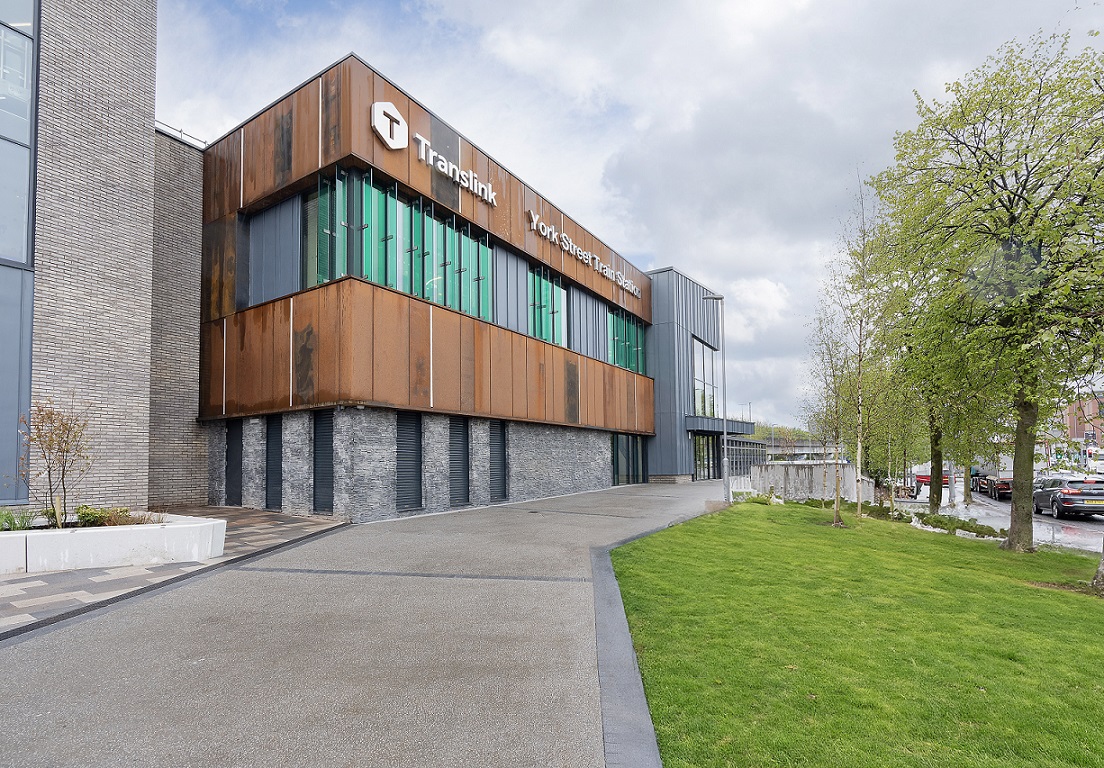
York Street Station Belfast
Belfast’s new state-of-the-art Grand Central Station opened its doors in September 2024, replacing the train station at Great Victoria Street (and Europa Buscentre) and offering rail services on the Derry~Londonderry line, Larne line; Bangor line; Portadown line and cross-border to Dublin. The station is an integrated transport hub, with 8 railway platforms and 26 bus stands.
Belfast Grand Central Station also saw enhanced connectivity between Belfast and Dublin, with hourly Enterprise services operating 15 times per day each way, Monday to Saturday and eight each way on Sundays, the most significant expansion of services on the route in over a quarter of a century. Procurement of new Enterprise fleet is underway. Outside Belfast Grand Central Station will be public realm space, Saltwater Square, with a strong emphasis on arts and culture, with potential to become a focal point for everyone to use and enjoy.
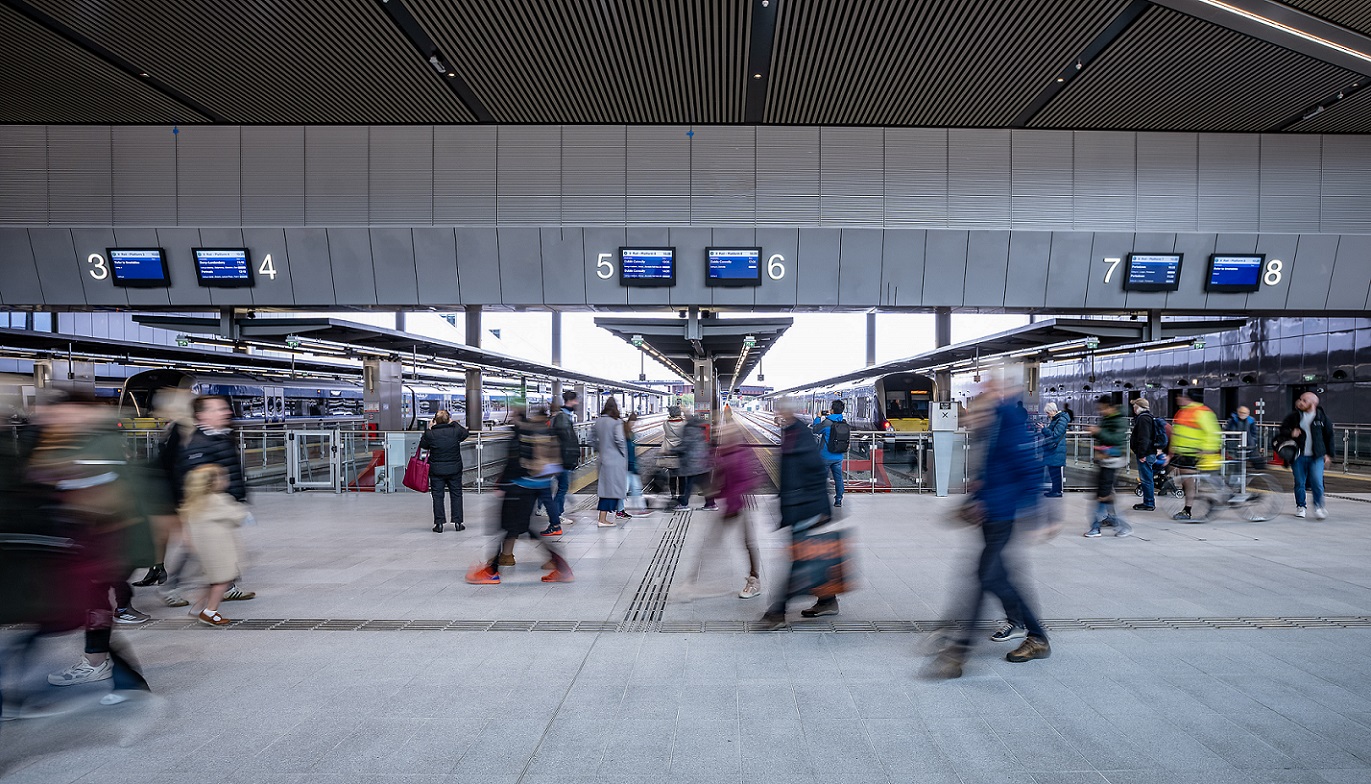
Belfast Grand Central Station platforms
Future Projects
The redevelopment of Lurgan Station will involve the demolition of the 1970s station and an adjacent building to provide a new passenger facility with a shelter canopy on both platforms and a pedestrian/cycle bridge linking the station building and platforms. The redevelopment will also provide an enhanced Park and Ride with increased capacity.
A new rail halt and park and ride facility is planned for Lisburn West, at lands east of the Knockmore Road in Lisburn. This project will deliver new platforms, a footbridge, realignment of the track and 350 car parking spaces, a bus turning area and cycle shelters.
Translink currently maintains a £5bn railway asset across Northern Ireland, including 300 miles of rail track and over 1,600 civil structures. A new Ballast Cleaning and Maintenance Depot proposed for Ballinderry will support the railway infrastructure, contribute to maintaining service reliability and reduce long term disruption.
References:
35 Years of NIR 1967-2002 - Jonathan M Allen
Dark Days and Brighter Days – Edwin McMillan
Main page photo: Belfast Central 3 at Donegall Road Station, May 1880